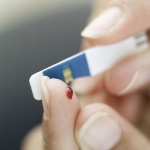
If you have hyperglycemia, you may not have any symptoms – although many people do. The signs include frequent urination, excessive thirst, dry mouth, blurry vision, fatigue, increased appetite, unexplained weight loss and dry, itchy skin.
High blood glucose can result from an imbalance in your food consumption, physical activity and medications, and may also occur when you are sick or under stress.
It can also be extremely dangerous.
If hyperglycemia persists for several hours, it could lead to dehydration as well as dizziness, breathing difficulties, drowsiness, confusion or unconsciousness. You could need an insulin shot, or even fall into a coma.
High blood sugar is also a symptom of diabetes or pre-diabetes. So it’s critical to see your doctor if you are experiencing high blood sugar symptoms.
How to Lower Your Blood Sugar
If your physician has ruled out diabetes, but you still have high blood sugar, chances are you are overweight. Eating too much – especially carbohydrates – can cause a rise in blood sugar levels; and failing to exercise can reduce the functioning of insulin.
Your doctor may prescribe medication to help lower your blood sugar, but there are several inexpensive ways you can do it yourself.
Reduce Carbs: Try the Glycemic Index Diet
Studies have shown that a diet controlling carbs is better at lowering blood sugar than a diet that is simply low in calories. The Glycemic Index Diet involves the consumption of foods and beverages with low glycemic index rankings to help keep your blood sugar balanced. The glycemic index (GI) ranks carbohydrate-laden foods on a scale of 0 to 100, according to the extent to which they raise blood sugar levels after eating.
Add Fibre
The Canadian Diabetes Association recommends soluble fibre as a way of controlling blood sugar. This is because soluble fibre delays stomach emptying, retards the entry of glucose into the bloodstream and lessens the rise in blood sugar after we’ve eaten.
Drink More Water
According to diabetes.co.uk, “when your blood sugar levels are running high, your body will try to flush excess sugar out of your blood through the urine. As a result, your body will need more fluids to rehydrate itself. Drinking water can help the body with flushing out some of the glucose in the blood.”
Drink Less Alcohol
Men should limit their alcohol intake to a maximum of 14 drinks a week; and women should have no more than nine.
Sleep Better
Studies have shown that our body’s ability to regulate insulin production can be disrupted by the quality and duration of our sleep. A good night’s sleep can be achieved through the avoidance of caffeine several hours before bed, exercising earlier in the day, and keeping consistent sleep and wake-up times.
Reduce Caffeine
Caffeine causes our bodies to release adrenaline, which is known to raise blood sugar levels. Health care professionals recommend consuming no more than 200 milligrams of caffeine a day, whether that be in the form of coffee, cola, tea, energy drinks or chocolate.
Avoid Sugar
You can still be sweet without consuming sugar. According to a ScienceDaily report, “in 2005, the average American consumed 64kg of added sugar, a sizeable proportion of which came through drinking soft drinks.” Sugar is also lurking in most processed foods and, of course, in cakes, cookies, cupcakes and other tasty treats. Limit your intake or avoid them all together.
Move Your Body
Researchers have discovered that exercise is linked to the way our liver dispenses glucose. A 30-minute walk each day can lower your blood sugar and blood glucose levels. But if you’re not accustomed to physical activity, take it easy at first. Exercising for just 10 minutes at a time can help.
De-stress
Emotional and mental stress, as well as physical stress caused by injury, infections or surgery, can increase the release of glucose into our bloodstream. Try to relax by socializing with friends, pampering yourself at home or a spa, or even chatting with a mental-health professional.
Remember: if your blood sugar levels seem out of control, see your doctor.